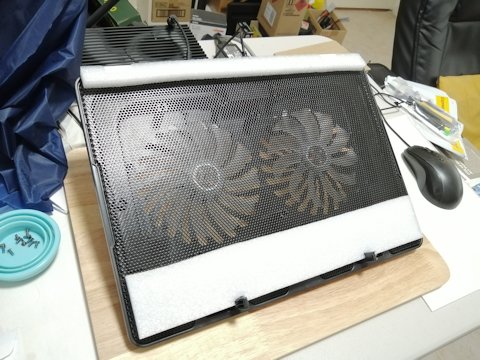Radical experiment to cool the laptop
I posted about an OpenEmbedded compile with the CPU set to "powersave" mode and all CPUs running at 1400MHz:
https://bkhome.org/news/202212/enhancing-the-acer-aspire-3-ryzen-5-laptop.html
Just let it run, compiling the entire 1,620 packages... it took 4 days and 3 hours!
As mentioned in that post, OE was set to use only 3 threads, also compiling of each package was with "make -j2", that is, only using 2 threads.
Decided to try a radical experiment, bought a tilted fan stand from Kmart, only AU$15 (about US$10):
https://www.kmart.com.au/product/laptop-stand-with-fans-43026623
The stand is plastic, however the fans are covered with a metal mesh, so applied closed-cell packaging foam top and bottom to provide some separation:

Took the back plate off the laptop, so that the fans will be blowing directly onto the components inside the laptop.
Wanted to recompile Chromium, as made some changes to the build recipe. Chromium takes the longest to compile and is a severe resource hog. It eats up the RAM. 16GB is needed, though the Aspire 3, my one anyway, shares that with the GPU, so more likely only about 14GB available.
I read one guy reported running out of storage when he had 32GB RAM, but he had set a high number of threads -- don't recall the number. Anyway, decided to leave "make -j2", given my laptops low RAM.
This time, set the CPU to "userspace" mode and set all CPUs to 1700MHz. Then started the recompile of Chromium. In the tray, CPU temperature was ranging from 70°C to 79°C. Summer here, and ambient temperature was probably varying between 25 and 28 -- not sure, as didn't actually measure it.
Chromium took about 20 hours to compile.
How to improve this? Increase that "make -j<n>", but the laptop will probably need more RAM. According to the offical Acer docs, it is already maxed-out, with 8GB soldered on the motherboard and 8GB on a SODIMM card (Samsung 8GB 1rx8 PC4-3200AA).
After an online search, did find posts some guys were able to increase that. One guy said that a 16GB RAM card worked, but there were problems with a 32GB card. No details were provided.
For example, what would be best, a 16GB 1rx8, 2rx8, or 1rx16? I read that x16 cards are bad news. My local computer parts shop has a 2rx8, so will probably try that. That will bump the laptop to 24GB, take off about 2GB for the GPU.
Right, so likely that will be the next experiment. Put the cover back onto the laptop, but still use the fan-stand. Bump the RAM with a 16GB SODIMM card, and try compile Chromium with more threads.
There is very good reason why I set "make -j2" globally for OE. In the past, a higher figure caused some package builds to fail. However, it can be set on a per-package basis, so I could try, say "-j4" for Chromium only. That may considerably speed up the build, but may also result in the CPU running hotter.
One interesting note: most Aspire 3 laptops only have 4GB RAM soldered onto the motherboard. I looked at aliexpress.com, and all the replacement motherboards for my Aspire 3 Ryzen 5 A315-23 only have 4GB RAM. The Aspire 3 family has incredible variability. Acer have used a common housing, screen, etc., with an incredible variety of models.
It is very interesting to experiment with this Ryzen 5 3500U CPU. It supports 1400, 1700 and 2100MHz frequencies, but also has a turbo, or boost, 3700MHz. I think, before had set the CPU to fixed frequencies, that turbo-mode was kicking in, which pushed the temperature to 90°C and over, and the fan to maximum speed. Note that turbo-mode can be turned off, by doing this:
# echo "0" > /sys/devices/system/cpu/cpufreq/boost
...I noticed that my Intel i3 CPU doesn't have that
"boost".
Tags: tech
